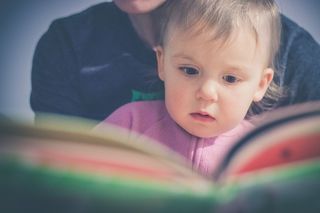In fact, the American Academy of Pediatrics suggests that parents should begin reading to infants as soon as possible (High et al., 2014). This recommendation is based on classic research showing that children whose parents talk to them more have an advantage in school over children whose parents talk to them less (Hart & Risley, 1995).
The key difference seems to lie in the number of words children are exposed to when parents speak to them aloud. This advantage is evident by the time children are two years old; children at this age who are spoken to more by their parents at 18 months understand and produce more words at age 2 (Hurtado, Marchman, & Fernald, 2008).
Further, besides talking to children, reading to them aloud also likely exposes children to new and different words that parents don’t often use regularly in everyday speech. Along these lines, studies have shown that the number of words infants produce and understand is predicted by how much they are read to (e.g., Robb, Richert, Wartella, 2009).

Source: Creative Commons/Public Domain
Besides benefits for word exposure, there is also evidence that babies can learn specific content from books, which can begin even before a baby is born. In fact, researchers have found that babies can learn the rhythm of a specific storybook in the third trimester of pregnancy.
To test this possibility, researchers asked women who were 7 months pregnant to read The Cat in the Hat to their bellies twice a day until the end of their pregnancies. When these babies were born, they preferred hearing The Cat in the Hat to other stories.
How do we know? The clever researchers hooked up a pacifier to two speakers, and programmed it so that when an infant sucked quickly, one story would play, and when an infant sucked slowly, a different story would play. The babies figured out quickly that they were controlling the scenario and sucked in a way that specifically produced The Cat in the Hat—the story they heard repeatedly in the womb (DeCasper & Spence, 1987). These babies weren’t learning the words in the story per se; they were just responding to the rhythm of the familiar tale, and preferred hearing it over similar narrations.
Infants can start learning specific words from stories shortly after their first birthday. After hearing a new object name in a picture book, babies aged 15 to 18 months are able to transfer that new name to a real object, and even to drawings of the object (Ganea, Pickard, & DeLoache, 2008). A little later, infants can learn new actions from a book as well.
In one study, researchers presented 18- to 30-month-old infants with a book that demonstrated how to put several objects together to make something new. After the storybook reading, the infants were able to learn how to successfully assemble several parts of a rattle and imitate specific movements, demonstrating that before the age of 2, infants can learn both words and actions from short and simple storybook interactions (Simcock & DeLoache, 2006).
Besides words and actions, by preschool age, children can learn pretty sophisticated information from storybooks. For example, one study reported that a short story book can teach children about camouflage in animals. In the study, 3- and 4-year-olds were read a story about how camouflage in animals can help them hide from dangerous predators. Later when asked about which animals a hungry bird might eat, children were able to deduce that a brown camouflaged lizard would be hidden from the bird, while his brightly colored friend would be more likely to get eaten (Ganea, Ma, & DeLoache, 2011).
Slightly older children can even learn about natural selection and evolution from a simple storybook. In one study, 5- and 6-year-olds were introduced to fictional animals called the Piloses that evolved skinny noses. Over the course of the book, children were provided with a detailed description about how the Piloses slowly changed over the course of many generations. After the book reading, both younger and older children learned that adaptation involves an extended process that results in different rates of survival and reproduction. They were even able to recall this information 3 months later and apply it to a new species (Kelemen, Emmons, Seston Schillaci, & Ganea, 2014; note, you can actually purchase this book online).
Altogether, simple storybooks have the power to teach infants and children new words, actions, and even more complex scientific concepts like camouflage and evolution. Note that these books were all designed to read like storybooks—not like educational books that children get in school—and children’s interactions with these books were very brief. Yet children still learned from them.
Besides learning, reading to infants and children can have other benefits too. A mother’s voice is familiar and comforting, even to newborns, so reading a book every night can help establish a calming and consistent sleep routine. Reading storybooks can also potentially foster an early interest in reading before children reach school age. Perhaps most importantly, reading together is a time that parents can spend with their kids doing something they both enjoy and comes with the added bonus of educational and personal benefits that can endure for years.
References
DeCasper, A. J., & Spence, M. J. (1987). Prenatal maternal speech influences newborns’ perception of speech sounds. Annual progress in child psychiatry and child development, 5-25.
Ganea, P. A., Ma, L., & DeLoache, J. S. (2011). Young children’s learning and transfer of biological information from picture books to real animals. Child Development, 82(5), 1421-1433.
Ganea, P. A., Pickard, M. B., & DeLoache, J. S. (2008). Transfer between picture books and the real world by very young children. Journal of Cognition and Development, 9(1), 46-66.
No comments:
Post a Comment